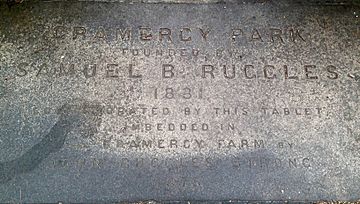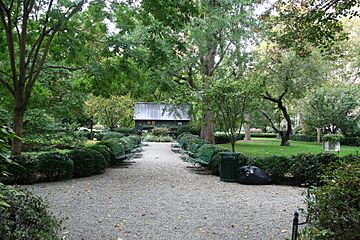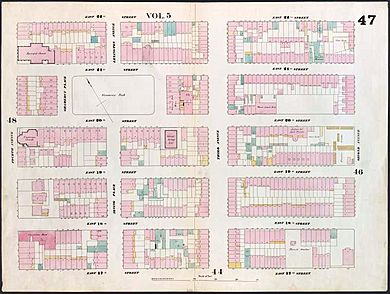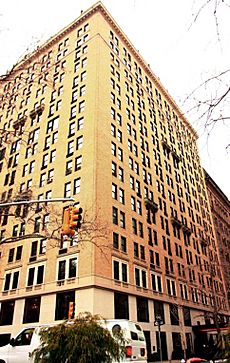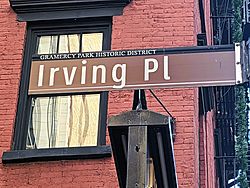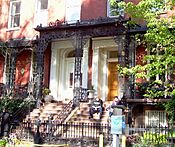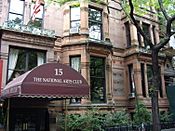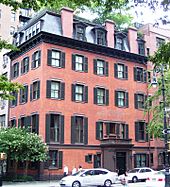Gramercy Park facts for kids
Quick facts for kids
Gramercy Park
|
|
|---|---|
|
Neighborhood and park
|
|
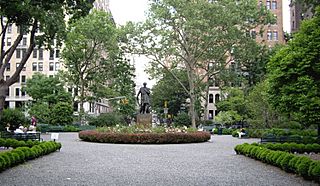
The view from the south gate of Gramercy Park, looking north from Gramercy Park South (East 20th Street), with the statue of Edwin Booth in the center. The Gramercy Park Hotel is visible in the left background. (May 2007)
|
|
| Country | |
| State | |
| City | New York City |
| Borough | Manhattan |
| Community District | Manhattan 5, Manhattan 6 |
| Population
(2010)
|
|
| • Total | 27,988 |
| Time zone | UTC−5 (Eastern) |
| • Summer (DST) | UTC−4 (EDT) |
| ZIP Codes |
10003, 10010
|
| Area code(s) | 212, 332, 646, and 917 |
|
Gramercy Park Historic District
|
|
 |
|
| Location | Manhattan, New York City Roughly bounded by:
|
| Architectural style | Greek Revival, Italianate, Gothic Revival |
| NRHP reference No. | 80002691 |
| Added to NRHP | January 23, 1980 |
Gramercy Park is a special place in Manhattan, New York City. It's both a small, private park with a fence and the name of the neighborhood around it.
This park is about 2 acres big and is part of the Gramercy Park Historic District. It's one of only two private parks in New York City. This means only people who live around the park and pay a yearly fee get a key to enter. The public usually can't go inside. However, the sidewalks around the park are popular for walking, jogging, and dog walking.
The neighborhood is known for being quiet and safe. Many people have said good things about Gramercy Park. It's unique in the country because it has stayed mostly the same for a long time.
Contents
Exploring Gramercy Park
Where is Gramercy Park?
Gramercy Park itself is located between East 20th Street (called Gramercy Park South) and East 21st Street (called Gramercy Park North). It's also between Gramercy Park West and Gramercy Park East. These are two streets that run between Park Avenue South and Third Avenue.
Irving Place starts at the south end of Gramercy Park and goes down to 14th Street. Lexington Avenue ends at the north side of the park.
What are the Neighborhood Boundaries?
The Gramercy Park neighborhood has clear boundaries. It's bordered by 14th Street to the south and First Avenue to the east. To the north, it reaches 23rd Street, and to the west, it's bordered by Park Avenue South.
Nearby neighborhoods include the Flatiron District to the west and Union Square to the southwest. To the south is the East Village, and to the east are Stuyvesant Town and Peter Cooper Village.
Gramercy Park Historic District
The Gramercy Park Historic District was created in 1966 and made larger in 1988. Its boundaries are a bit uneven and are inside the larger neighborhood. You can see them on the map in the box at the top of this page. There's also a plan to make the district even bigger.
What's in a Name?
The Meaning of "Gramercy"
The name "Gramercy" comes from an old Dutch word, Crommessie. This word means 'little crooked swamp' or 'little crooked knife'. It described the shape of the swamp, brook, and hill that used to be in this area.
The brook, called Crommessie Vly, flowed in a deep ditch along what is now 21st Street. Later, in 1761, a man named James Duane bought the land and called it Gramercy Seat. The word Gramercy is an old English word that means 'many thanks'.
History of Gramercy Park
How the Park Began
A long time ago, the area where Gramercy Park is now was a swamp. In 1831, a man named Samuel B. Ruggles had an idea for a park. He wanted to create an open green space as New York City grew northward.
Ruggles bought 22 acres of land, which was then a farm. He spent a lot of money, $180,000, to drain the swamp and shape the land. He then created "Gramercy Square" and gave the land to the owners of the 66 plots around it. The city also agreed that the park wouldn't have to pay taxes.
This was the second private park created in New York City. The first was Hudson Square. The park was surrounded by a fence in 1833. However, building houses around it didn't start until the 1840s because of a financial crisis. Luckily, by then, the city had a new water system, so new homes could have indoor plumbing.
The park's gates were first locked in 1844. Trees and shrubs were planted to make the park beautiful.
Important Moments in the 1800s
In 1863, during the American Civil War, something special happened. Gramercy Park was opened to Union soldiers. This was during the Draft riots in New York, when there was a lot of unrest.
Some of New York's first apartment buildings were built near the park. For example, No. 34 and No. 36 Gramercy Park (East) were designed in 1883 and 1905. No. 34 is also the oldest co-operative apartment building in the city. Many old brownstone houses and carriage houses from the 1800s can still be seen in the neighborhood.

In 1890, there was a plan to run a cable car through the park. This idea was stopped by the governor. Later, in 1912, another plan to cut through the park was also stopped by a group called the Gramercy Park Association.
Many groups that helped people were located on 23rd Street in the late 1800s. Some are still there today. The Brotherhood Synagogue on Gramercy Park South was even a stop on the Underground Railroad before the Civil War. At that time, it was a Quaker meeting house.
Gramercy Park in the 1900s and 2000s
The Hotel Irving, built around 1903, was a popular place to stay. A famous writer, Preston Sturges, stayed there when he was young.
In the middle of the park, you'll find a statue of Edwin Booth. He was a very famous actor in the 1800s and the brother of John Wilkes Booth. Booth bought the mansion at No. 16 Gramercy Park (South) and made it the home of The Players' Club, which he started.
Next door, at No. 15 Gramercy Park (South), is the National Arts Club. This club is in a beautiful old mansion that used to belong to Samuel J. Tilden, a former New York Governor.
On September 20, 1966, part of the Gramercy Park neighborhood was named an historic district. This means its old buildings and unique character are protected.
In 1983, a bronze sculpture called Fantasy Fountain was placed in the park.
In 1989, a large steam pipe burst near Gramercy Park. This caused a lot of damage to buildings in the area.
In 2012, a tall building at 18 Gramercy Park South was sold and turned into fancy apartments. This building is the tallest around the park and was built in 1927.
Park Ownership and Access
Since 1831, Gramercy Park has been owned by the people who own the 39 buildings around it. Each of these original properties gets two keys to the park. Owners can buy keys for a fee, which was $350 in 2008. If a key is lost, the fee to replace it is much higher.
The locks on the park gates are changed every year. The keys are also very hard to copy. If a property doesn't pay its yearly fee, its key privileges are taken away. In 2012, there were 383 keys in use.
Members of Players Club and the National Arts Club can also get keys. Guests staying at the Gramercy Park Hotel can use the hotel's keys, but they are usually escorted by hotel staff.
The park used to be open to the public once a year on "Gramercy Day." However, the park's managers stopped this in 2007 because it became too crowded. The park is still open to the public on Christmas Eve.
When visiting the park, people are not allowed to drink alcohol, smoke, ride bicycles, walk dogs, play ball or Frisbee, or feed the birds and squirrels.
People in Gramercy Park
In 2010, the population of Gramercy Park was 27,988 people. The neighborhood is generally seen as a quiet and safe place to live.
The buildings in Gramercy Park are not super tall, usually around 20 stories. This is because the bedrock underground is deeper here. Many older buildings with 3 to 6 floors are common, especially on the side streets.
The quiet streets near Irving Place are known for being fashionable residential areas, similar to parts of London. East 19th Street between Third Avenue and Irving is even called "Block Beautiful" because of its many different types of architecture.
Gramercy Park Hotel
The Gramercy Park Hotel was built in 1925. It was completely updated in 2006 by Ian Schrager and artist Julian Schnabel. The hotel has great views of Gramercy Park. Guests staying at the hotel can use its 12 keys to access the park. The hotel also has restaurants and bars.
Irving Place
Irving Place is a main street in the neighborhood south of the park. It has many restaurants, bars, and shops. Pete's Tavern, one of New York's oldest surviving bars, is here. It's said that the writer O. Henry might have written "The Gift of the Magi" there. Irving Plaza is also on Irving Place. It's a popular place for concerts.
Learning in Gramercy Park
Schools in the Area
Gramercy Park has several schools.
- Two public high schools: Washington Irving High School and the School of the Future. The School of the Future is also a middle school.
- P.S. 40, the Augustus Saint-Gaudens School, is an elementary school for grades Pre-K to 5.
- The Salk School of Science and M.S. 104 the Simon Baruch Middle School are middle schools for grades 6–8.
- The American Sign Language and English School teaches deaf and hearing children using American Sign Language.
- The Epiphany School is a Catholic elementary school.
- The Learning Spring School is a private school for children with autism.
- The École Internationale de New York is a French international school with different grades in various buildings.
Colleges and Universities
Several colleges have buildings in or near Gramercy Park:
- Baruch College of the City University of New York (CUNY) has facilities here.
- The School of Visual Arts has buildings and dorms in the area.
- New York University's Gramercy Green dormitory is also in the neighborhood.
Local Library
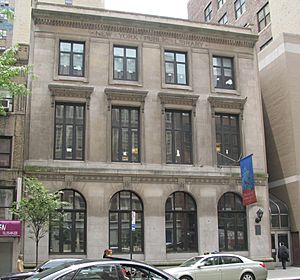
The New York Public Library has its Epiphany branch at 228 East 23rd Street. This library first opened in 1887.
Hospitals and Services
Gramercy Park is close to several medical centers.
- Beth Israel Medical Center is nearby.
- The Hospital for Joint Diseases and the New York Eye and Ear Infirmary are also in the area.
- The former Cabrini Medical Center buildings are now used by Memorial Sloan-Kettering Cancer Center.
Post Office and ZIP Codes
Gramercy Park uses two ZIP Codes: 10003 for the area south of 20th Street and 10010 for the area north of 20th Street. The United States Postal Service has a post office called Madison Square Station on East 23rd Street.
Famous People of Gramercy Park
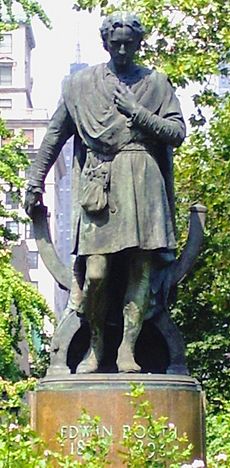
Many notable people have lived in Gramercy Park over the years.
Around the Park
- No. 3 & 4: James Harper, a former Mayor of New York and founder of a publishing company, lived here. The two iron lamps outside No. 4 were placed by the city in his honor.
- No. 15: Samuel J. Tilden, a New York Governor, lived in the house that is now the National Arts Club.
- No. 16: Edwin Booth, the famous actor, founded The Players club here.
- No. 24: The inventor Thomas Alva Edison and former Secretary of the Treasury Albert Gallatin lived in this house.
- No. 34: Actors James Cagney, Margaret Hamilton, and Gregory Peck lived in this building.
- No. 36: Actor John Barrymore and sculptor Daniel Chester French (who created the Lincoln Memorial statue) lived here.
- No. 38: The author John Steinbeck lived in this building.
- Where the Gramercy Park Hotel is now: Architect Stanford White and orator Robert G. Ingersoll once lived on this site.
- Other residents around the park: Actress Frances Bavier (Aunt Bee from The Andy Griffith Show), actor Vincent D'Onofrio, TV host Jimmy Fallon, fashion designer Karl Lagerfeld, and actress Uma Thurman.
Around the Neighborhood
- Peter Cooper, a famous industrialist and philanthropist, lived just north of the park.
- Theodore Roosevelt's birthplace is on 20th Street.
- Author Edith Wharton was born on West 23rd Street.
- Writer Oscar Wilde stayed on Irving Place for a time.
- Chelsea Clinton, daughter of former President Bill Clinton, used to live in the neighborhood.
Many actors, artists, and models live in the area today. These include Kate Hudson, Joshua Bell, Jimmy Fallon, and Amanda Peet (who grew up here). News anchor Ann Curry also lives in the neighborhood.
Images for kids
- Around the Park
-
#3 & 4: Doorways of the Greek Revival townhouses, design attributed to Alexander Jackson Davis, "one of America's most versatile 19th century architects"
-
#15: The National Arts Club, former home of Samuel J. Tilden, remodeled for Tilden by Calvert Vaux
-
#19, built in 1845 and remodeled in 1887 for Stuyvesant Fish. John Barrymore lived here while working on Broadway.
-
#28: The Brotherhood Synagogue was a stop on the Underground Railroad when it was a Quaker meeting house The Travelers' Aid Society grew out of one of the congregation's activities.
- Around the neighborhood
-
Italianate townhouses on East 18th Street (1853), with cast-iron verandas reminiscent of the French Quarter of New Orleans.
-
Steeple of Epiphany Roman Catholic Church, "The most positive modernist religious statement on Manhattan Island to date."
-
Pete's Tavern, where urban legend has it that O. Henry wrote "The Gift of the Magi", was formerly the Portman Hotel.
See also
 In Spanish: Gramercy Park para niños
In Spanish: Gramercy Park para niños


